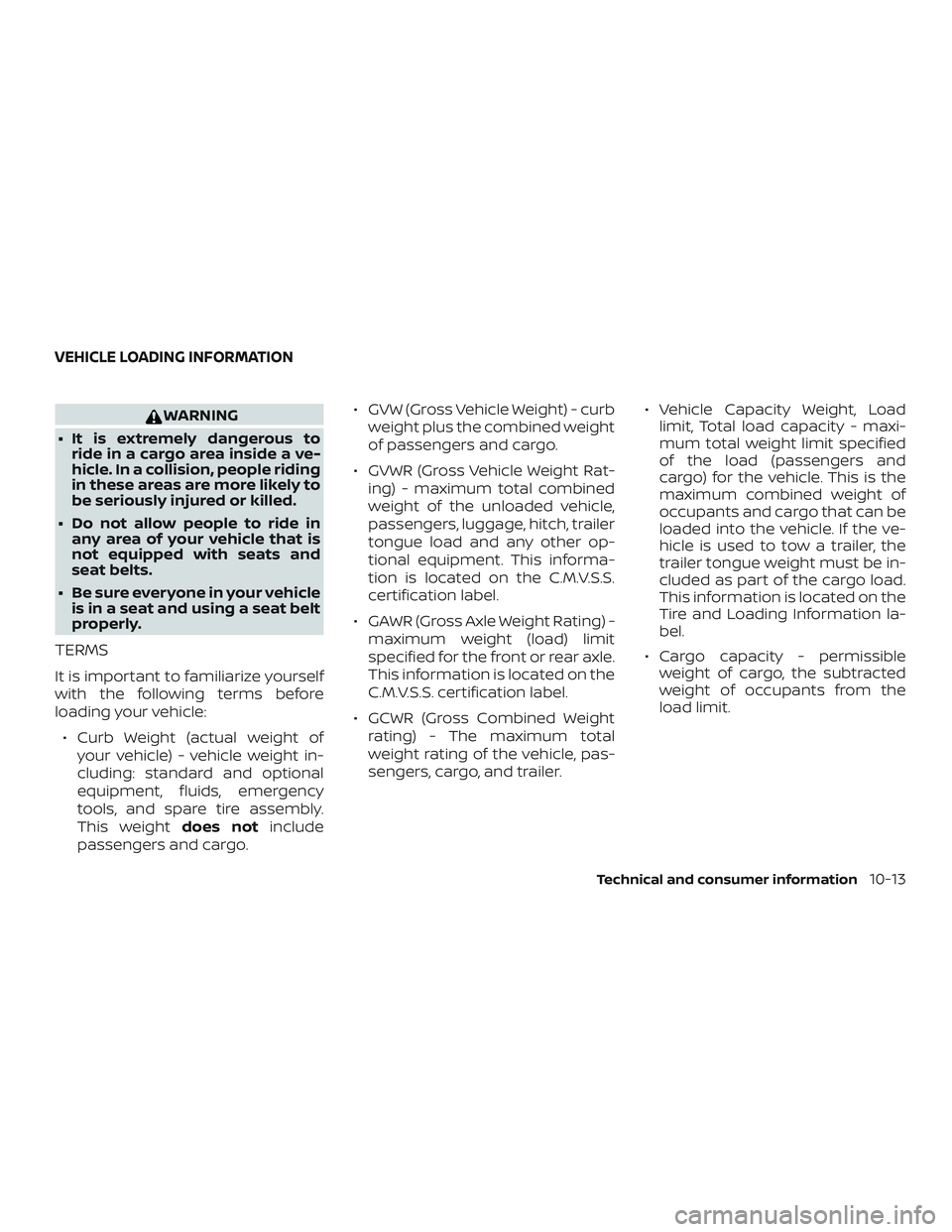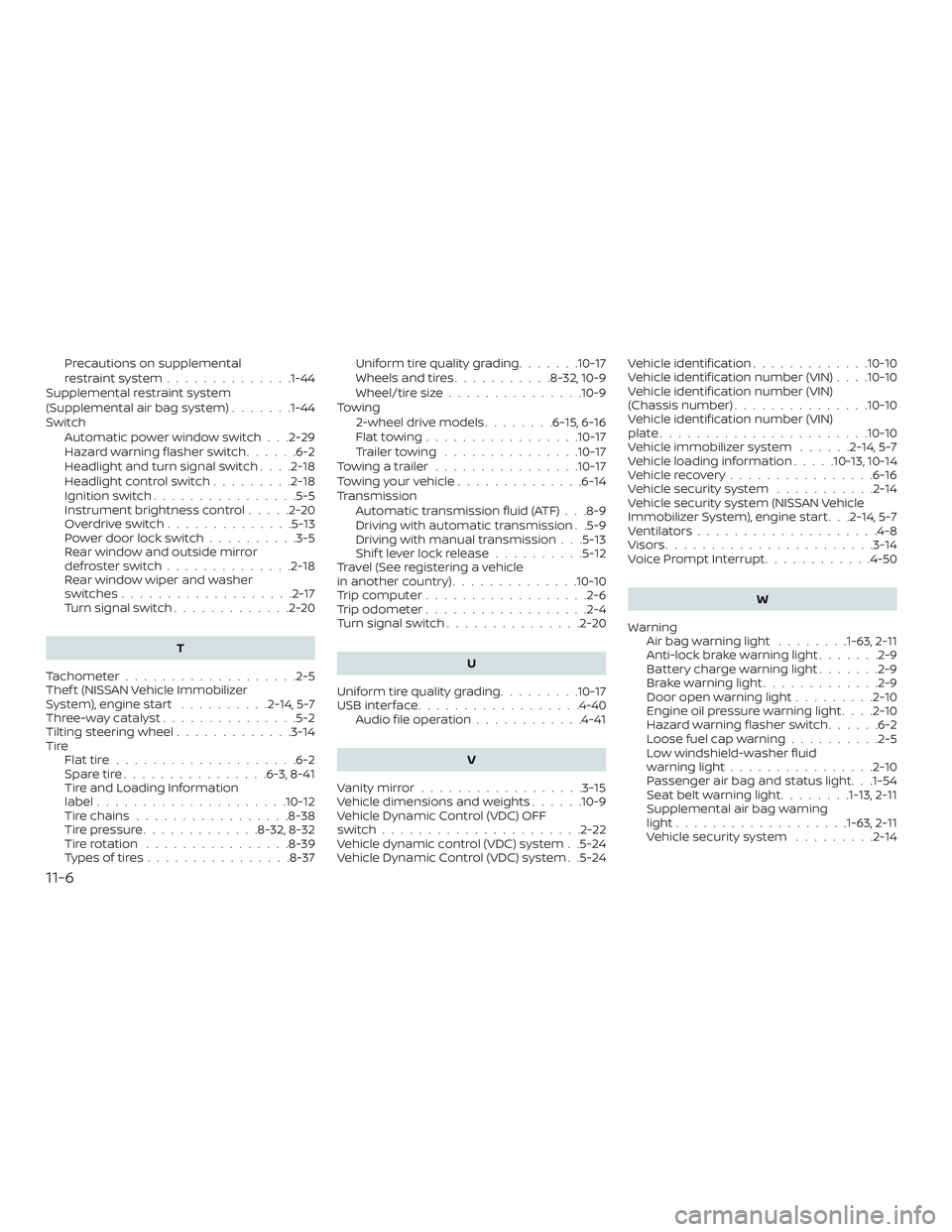2018 NISSAN MICRA trailer
[x] Cancel search: trailerPage 123 of 330

WARNING
∙ Gasoline is extremely flammable andhighly explosive under certain condi-
tions. You could be burned or seri-
ously injured if it is misused or mis-
handled. Always stop the engine and
do not smoke or allow open flames or
sparks near the vehicle when
refueling.
∙ Do not attempt to top off the fuel tank af ter the fuel pump nozzle shuts off
automatically. Continued refueling
may cause fuel overflow, resulting in
fuel spray and possibly a fire.
∙ Use only an original equipment type fuel-filler cap as a replacement. It has
a built-in safety valve needed for
proper operation of the fuel system
and emission control system. An in-
correct cap can result in a serious mal-
function and possible injury. It could
also cause the Malfunction Indicator
Light (MIL) to come on.
∙ Never pour fuel into the throttle body to attempt to start your vehicle. ∙ Do not fill a portable fuel container in
the vehicle or trailer. Static electricity
can cause an explosion of flammable
liquid, vapor or gas in any vehicle or
trailer. To reduce the risk of serious
injury or death when filling portable
fuel containers:
– Always place the container on the ground when filling.
– Do not use electronic devices when filling.
– Keep the pump nozzle in contact with the container while you are
filling it.
– Use only approved portable fuel containers for flammable liquid.
CAUTION
∙ Do not use a fuel containing morethan 15% ethanol in your vehicle. For
additional information, refer to “Fuel
Recommendation” in the “Technical
and consumer information” section of
this manual. ∙ Failure to tighten the fuel-filler cap
properly may cause the
Mal-
function Indicator Light (MIL) to illumi-
nate. If the
light illuminates be-
cause the fuel-filler cap is loose or
missing, tighten or install the cap and
continue to drive the vehicle.
The
light should turn off af ter a
few driving trips. If the
light does
not turn off af ter a few driving trips,
have the vehicle inspected. It is rec-
ommended that you visit a NISSAN
dealer for this service.
∙ The LOOSE FUEL CAP warning mes- sage will be displayed if the fuel-filler
cap is not properly tightened. It may
take a few driving trips for the mes-
sage to be displayed. Failure to
tighten the fuel-filler cap properly af-
ter the LOOSE FUEL CAP warning mes-
sage is displayed/warning appears
may cause the
Malfunction Indi-
cator Light (MIL) to illuminate.
∙ For additional information, refer to the “Malfunction Indicator Light (MIL)”
in the “Instruments and controls” sec-
tion of this manual.
3-12Pre-driving checks and adjustments
Page 283 of 330

∙ Tire tread of the TEMPORARY USEONLY spare tire will wear at a faster
rate than the standard tire. Replace
the spare tire as soon as the tread
wear indicators appear.
∙ Do not use the spare tire on other vehicles.
∙ Do not use more than one spare tire at the same time.
∙ Do not tow a trailer when the TEMPO- RARY USE ONLY spare tire is installed.
CAUTION
∙ Do not use tire chains on a TEMPO-RARY USE ONLY spare tire. Tire chains
will not fit properly and may cause
damage to the vehicle.
∙ Because the TEMPORARY USE ONLY spare tire is smaller than the original
tire, ground clearance is reduced. To
avoid damage to the vehicle, do not
drive over obstacles. Also, do not drive
the vehicle through an automatic car
wash since it may get caught.
8-42Do-it-yourself
Page 300 of 330

10 Technical and consumer information
Recommended fluids/lubricants and
capacities...................................... 10-2
Fuel recommendation ....................... 10-3
Engine oil and oil filter
recommendations .......................... 10-6
Air conditioner system (if so equipped)
refrigerant and oil recommendations ........10-7
Specifications .................................. 10-8
Engine ...................................... 10-8
Wheels and tires ............................. 10-9
Dimensions and weights ....................10-9
When traveling or registering in another
country ........................................ 10-10
Vehicle identification .......................... 10-10
Vehicle Identification Number (VIN)
plate ....................................... 10-10
Vehicle identification number
(chassis number) ........................... 10-10
Engine serial number ........................ 10-11
C.M.V.S.S. certification label ...................10-11Emission control information label
..........10-11
Tire and Loading Information label .........10-12
Air conditioner specification label
(if so equipped) ............................. 10-12
Installing front license plate (if so equipped) . . . 10-12
Vehicle loading information ...................10-13
Terms ...................................... 10-13
Determining vehicle load capacity ..........10-14
Loading tips ................................ 10-16
Measurement of weights ...................10-16
Towing a trailer ................................ 10-17
Flat towing ................................. 10-17
Uniform tire quality grading ....................10-17
Emission control system warranty .............10-18
Reporting safety defects ......................10-19
Readiness for Inspection/Maintenance (I/M)
test ............................................ 10-19
Event Data Recorders (EDR) ....................10-20
Owner’s Manual/Service Manual order
information ................................... 10-20
Page 312 of 330

WARNING
∙ It is extremely dangerous to ride in a cargo area inside a ve-
hicle. In a collision, people riding
in these areas are more likely to
be seriously injured or killed.
∙ Do not allow people to ride in any area of your vehicle that is
not equipped with seats and
seat belts.
∙ Be sure everyone in your vehicle is in a seat and using a seat belt
properly.
TERMS
It is important to familiarize yourself
with the following terms before
loading your vehicle:
∙ Curb Weight (actual weight of your vehicle) - vehicle weight in-
cluding: standard and optional
equipment, fluids, emergency
tools, and spare tire assembly.
This weight does notinclude
passengers and cargo. ∙ GVW (Gross Vehicle Weight) - curb
weight plus the combined weight
of passengers and cargo.
∙ GVWR (Gross Vehicle Weight Rat- ing) - maximum total combined
weight of the unloaded vehicle,
passengers, luggage, hitch, trailer
tongue load and any other op-
tional equipment. This informa-
tion is located on the C.M.V.S.S.
certification label.
∙ GAWR (Gross Axle Weight Rating) - maximum weight (load) limit
specified for the front or rear axle.
This information is located on the
C.M.V.S.S. certification label.
∙ GCWR (Gross Combined Weight rating) - The maximum total
weight rating of the vehicle, pas-
sengers, cargo, and trailer. ∙ Vehicle Capacity Weight, Load
limit, Total load capacity - maxi-
mum total weight limit specified
of the load (passengers and
cargo) for the vehicle. This is the
maximum combined weight of
occupants and cargo that can be
loaded into the vehicle. If the ve-
hicle is used to tow a trailer, the
trailer tongue weight must be in-
cluded as part of the cargo load.
This information is located on the
Tire and Loading Information la-
bel.
∙ Cargo capacity - permissible weight of cargo, the subtracted
weight of occupants from the
load limit.
VEHICLE LOADING INFORMATION
Technical and consumer information10-13
Page 316 of 330

Do not tow a trailer with your vehicle.
FLAT TOWING
Towing your vehicle with all four wheels on
the ground is sometimes called flat towing.
This method is sometimes used when
towing a vehicle behind a recreational ve-
hicle, such as a motor home.
CAUTION
∙ Failure to follow these guidelines canresult in severe transmission damage.
∙ Whenever flat towing your vehicle, al- ways tow forward, never backward.
∙
Never tow your front wheel drive vehicle
with the front tires on the ground. Doing
so may cause serious and expensive
damage to the powertrain.
∙ DO NOT tow any continuously variable transmission vehicle with all four
wheels on the ground (flat towing).
Doing so WILL DAMAGE internal trans-
mission parts due to lack of transmis-
sion lubrication.
∙ For emergency towing procedures re- fer to “Towing recommended by
NISSAN” in the “In case of emergency ”
section of this manual.
Manual Transmission
(if so equipped)
∙ Always tow with the manual transmis- sion in Neutral.
∙ Af ter towing 805 km (500 miles), start and idle the engine with the transmis-
sion in Neutral for two minutes. Failure
to idle the engine af ter every 805 km
(500 miles) of towing may cause dam-
age to internal transmission parts.
Automatic Transmission
(if so equipped)
To tow a vehicle equipped with an auto-
matic transmission, an appropriate vehicle
dolly MUST be placed under the towed ve-
hicle’s drive wheels. Alwaysfollow the dolly
manufacturer’s recommendations when
using their product. DOT (Department of Transportation) Qual-
ity Grades: All passenger car tires must
conform to federal safety requirements in
addition to these grades.
Quality grades can be found where appli-
cable on the tire sidewall between tread
shoulder and maximum section width. For
example:
Treadwear 200 Traction AA Temperature A
Treadwear
The treadwear grade is a comparative rat-
ing based on the wear rate of the tire when
tested under controlled conditions on a
specified government test course. For ex-
ample, a tire graded 150 would wear one
and one-half (1 1/2) times as well on the
government course as a tire graded 100.
The relative performance of tires depends
upon the actual conditions of their use,
however, and may depart significantly from
the norm due to variations in driving habits,
service practices and differences in road
characteristics and climate.
TOWING A TRAILER
UNIFORM TIRE QUALITY GRADING
Technical and consumer information10-17
Page 325 of 330

Precautions on supplemental
restraint system..............1-44
Supplemental restraint system
(Supplemental air bag system) .......1-44
Switch Automatic power window switch . . .2-29
Hazard warning flasher switch ......6-2
Headlight and turn signal switch ....2-18
Headlightcontrolswitch.........2-18
Ignition switch ................5-5
Instrument brightness control .....2-20
Overdriveswitch..............5-13
Power door lock switch ..........3-5
Rear window and outside mirror
defrosterswitch..............2-18
Rear window wiper and washer
switches ...................2-17
Turn signal switch .............2-20
T
Tachometer ...................2-5
Thef t (NISSAN Vehicle Immobilizer
System), engine start ..........2-14,5-7
Three-waycatalyst...............5-2
Tilting steering wheel .............3-14
Tire Flattire....................6-2
Spare tire ................6-3,8-41
Tire and Loading Information
label .....................10-12
Tire chains .................8-38
Tire pressure .............8-32,8-32
Tirerotation ................8-39
Types of tires ................8-37 Uniform tire quality grading
.......10-17
Wheels and tires ...........8-32,10-9
Wheel/tire size ...............10-9
Towing 2-wheel drive models ........6-15,6-16
Flattowing.................10-17
Trailertowing ...............10-17
Towingatrailer................10-17
Towingyourvehicle..............6-14
Transmission Automatic transmission fluid (ATF) . . .8-9
Driving with automatic transmission . .5-9
Driving with manual transmission . . .5-13
Shiftleverlockrelease..........5-12
Travel (See registering a vehicle
in another country) ..............10-10
Trip computer ..................2-6
Trip odometer ..................2-4
Turn signal switch ...............2-20
U
Uniform tire quality grading .........10-17
USBinterface..................4-40 Audio file operation ............4-41
V
Vanitymirror..................3-15
Vehicle dimensions and weights ......10-9
Vehicle Dynamic Control (VDC) OFF
switch......................2-22
Vehicle dynamic control (VDC) system . .5-24
Vehicle Dynamic Control (VDC) system . .5-24 Vehicle identification
.............10-10
Vehicle identification number (VIN) . . . .10-10
Vehicle identification number (VIN)
(Chassis number) ...............10-10
Vehicle identification number (VIN)
plate.......................10-10
Vehicle immobilizer system ......2-14,5-7
Vehicle loading information .....10-13,10-14
Vehiclerecovery................6-16
Vehicle security system ...........2-14
Vehicle security system (NISSAN Vehicle
Immobilizer System), engine start . . .2-14, 5-7
Ventilators ....................4-8
Visors.......................3-14
Voice Prompt Interrupt ............4-50
W
Warning Airbagwarninglight ........1-63, 2-11
Anti-lock brake warning light .......2-9
Battery charge warning light .......2-9
Brakewarninglight.............2-9
Door open warning light .........2-10
Engine oil pressure warning light . . . .2-10
Hazard warning flasher switch ......6-2
L o
osefuelcapwarning..........2-5
Low windshield-washer fluid
warninglight............... .2-10
Passenger air bag and status light. . .1-54
Seatbeltwarninglight........1-13, 2-11
Supplemental air bag warning
light.................. .1-63, 2-11
Vehicle security system .........2-14
11-6